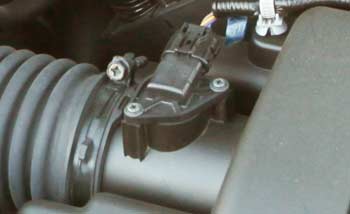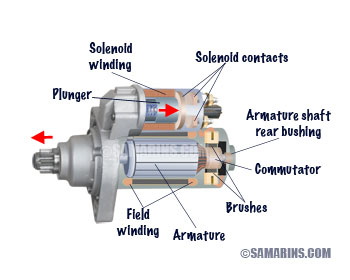10 Reasons the engine cranks but won't start
By Vlad Samarin Updated: January 25, 2023
In this guide, we are going to look into no-start problems when the engine turns over (cranks), but won't start. If your engine won't crank at all, or cranks very slow, or the security light stays on, check the first part: Car won't start: 3 common causes. Steps to diagnose. If your car has a push button start system, read this guide: Why a car won't start when you push the Start button?.If your engine cranks normally, but won't fire up, you know that at least your battery is in good shape and the starter motor works. First, check for common problems with cars like yours. Read more about common causes below.
Research common problems with your make, year and model
If your car won't start, there is a good chance that someone already had a similar problem with the same model vehicle and already found the solution. Search Google and Youtube for 'common cause your Make, Model and Year cranks but won't start'. There are websites where you can search for common problems reported by other owners:NHTSA Recalls - You can check for recalls and complaints for your car's make year and model.
Carcomplaints.com - search for common complaints.
For example, if you search NHTSA complaints for the 2002 Chevrolet Impala, selecting "Electrical System" you will find a number of no-start complaints related to the "Passlock" feature. Now, Google "Passlock" and you will find a number of threads at various forums and Youtube videos describing the problem and ways to fix it.
1. Engine is flooded
This problem is common, especially in high-mileage vehicles. The car starts then stalls out and doesn't re-start again. In some cases it might re-start when pressing the gas pedal lightly while starting. What happens is the excess gasoline fouls spark plugs and washes off oil from the piston rings, lowering the compression.Your mechanic may advise replacing or at least removing and drying out the spark plugs and if the battery is weak, re-charging the battery. Once spark plugs are removed, the excess gasoline dries out. With a fully-charged battery and clean spark plugs, the flooded engine should start if there are no other problems. Watch these YouTube videos to learn more.
2. Bad fuse, main relay, fuel pump or other relay
The fuel pump relay or fuse or main relay (module) failures are common in some vehicles. In many Honda cars, a failed PGM FI Main Relay could cause a car not to start.In some Chrysler and Dodge vehicles, a bad ASD relay was often responsible for a no-start. A bad FPDM module in some Ford vehicles could cause the same problem.
In some Chrysler, Dodge, Jeep cars, the corrosion at the relay/fuse box (TIPM module) is another problem that can cause a no start. While researching, we found many complaints related to the Totally Integrated Power Module (TIPM) and not only about starting.
In some Ford F-150 vehicles, an overheated fuse F27 in the battery junction box (BJB) can cause the vehicle not to start. Read also: How to Check a Fuse in a Car.
In some GM trucks, the fuel pump control module (FPCM) is installed underneath, near the spare tire. It's a fairly common situation when water or corrosion can cause the module not to work. For example, we found this great video explaining the issue. Replacing the relay or module is not as expensive as some other problems.
3. Bad fuel pump
Fuel pumps are also known to fail. One day, a fuel pump just stops working and the engine cranks, but doesn't start with no fuel supply. We strongly recommend that you trust any fuel-related problems to a qualified technician due to fire hazard, as in most cars the fuel pump is installed inside the gas tank.When you take your vehicle to the repair shop, your mechanic will need to run a few tests. It's not difficult to find out if the car doesn't start because no fuel comes from the injectors. If the fuel pump doesn't run, your mechanic might have to check the electrical circuit, including the connector and the fuel pump relay.
4. Failed high-pressure fuel pump
A high-pressure fuel pump (HPFP) is another culprit for no-start and long crank problems. The high-pressure fuel pump is installed on the engine and is a part of direct fuel injection. When it's failing, first a car lacks power and needs to be cranked longer before the engine starts, then it dies completely. Search for HPFP problems in BMW 335i or 135i and you will find plenty.5. Failed mass air flow sensor
In many cars a failed mass air flow sensor can cause a car not to start. The car might start for a second, but stall immediately. Mechanics often use a known-good mass air flow sensor to test if the engine starts. Some mechanics try disconnecting the mass air flow sensor to see if the car starts without it. Replacing a mass air flow sensor is easy and not very expensive ($30-$160 part plus $50-$120 labor). Read more about the mass airflow sensor.6. Bad crank or cam sensor or sensor wiring
A crankshaft position sensor (crank sensor) is an important device measuring the engine RPM and tracing the crankshaft position. The car won't start if the crankshaft position sensor doesn't work properly. The crank sensor can fail, or its wiring can get damaged. This may cause the car to stall or not start. Often this happens intermittently. A crankshaft sensor can be tested with a scan tool or a multimeter. Read more about it here: Crankshaft position sensor.The camshaft position sensor or cam sensor works similarly except that it measures the rotation of the camshaft. Many cars have two cam sensors, one for each camshaft. Problems with the cam and crank sensor are common in many vehicles, including older Nissan and Chrysler models.
7. Dirty throttle body after replacing the battery
In some high-mileage cars if the throttle body is very dirty, it may cause a car not to restart after the battery has been replaced. Sometimes a car may only start if the gas pedal is pressed lightly. The problem is that as the throttle body gets dirty, the engine computer re-learns and adjusts the throttle body idle position. When the battery is disconnected, the learned throttle body idle position in the engine computer is erased. The solution is to clean the throttle body and perform the idle re-learn procedure.8. Faulty ignition coil pack
In some older cars, including GM and Volkswagen, an ignition coil pack was known to fail. Often it would happen in rainy weather or after washing the engine. Your mechanic can test the coil pack. The part is not very expensive. Now, most cars have separate ignition coils for each cylinder. Although they are also common to fail, they won't cause the engine not to start. Read more about ignition coils.9. Incorrect engine timing
Often this problem happens after replacing a timing belt or timing chain. If a car doesn't start after this repair, the timing must be double-checked.Advertisement
10. Low compression in the engine
An engine might lose compression in the cylinders after severe overheating or when a timing belt or chain skips. Replacing an engine, in this case, might be a better option than repairing it. Replacing an engine with a used unit costs from $1400 to $3300 depending on the part cost and the complexity of the work. With today's well-developed network of auto recyclers locating a used engine is not very difficult. We have seen many engines replaced successfully.Read Next:
3 reasons Car won't start: 3 common causes. Steps to diagnose. Troubleshooting tips.
Why a car won't start when you push the Start button?
2 Reasons Why a Car Won't Start in Park but Starts in Neutral
Starter motor, starting system: how it works, problems, testing
How to Check a Fuse in a Car?
3 reasons Car won't start: 3 common causes. Steps to diagnose. Troubleshooting tips.
Why a car won't start when you push the Start button?
2 Reasons Why a Car Won't Start in Park but Starts in Neutral
Starter motor, starting system: how it works, problems, testing
How to Check a Fuse in a Car?


